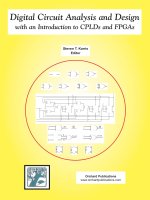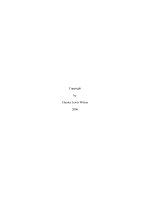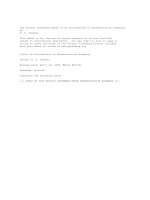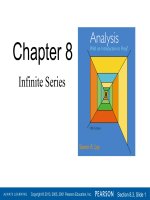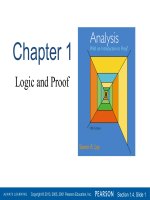Analysis with an introduction to proof 5th by steven lay ch01b
Bạn đang xem bản rút gọn của tài liệu. Xem và tải ngay bản đầy đủ của tài liệu tại đây (115.32 KB, 12 trang )
Chapter 1
Logic and Proof
Copyright © 2013, 2005, 2001 Pearson Education, Inc.
Section 1.4, Slide 1
1-1
Section 1.4
Techniques of Proof Il
Copyright © 2013, 2005, 2001 Pearson Education, Inc.
Section 1.4, Slide 2
1-2
Mathematical theorems and proofs do not occur in isolation, but always in the
context of some mathematical system. Knowing the context is particularly
important when dealing with quantified statements.
For example, the statement
∀ x,
x2 = x
is true in the context of the positive numbers, but is false for the real numbers.
Similarly, the statement
∃x
2
x = 25 and x < 3
is false for positive numbers and true for real numbers.
Copyright © 2013, 2005, 2001 Pearson Education, Inc.
Section 1.4, Slide 3
1-3
How do we prove quantified statements?
To prove a universal statement
∀ x, p (x),
we let x represent an arbitrary member from the system under consideration and then show that statement p (x) is true.
The only properties that we can use about x are those that apply to all the members of the system.
For example, if the system consists of the integers, we cannot use the property that x is even, since this does not apply to all the integers.
Copyright © 2013, 2005, 2001 Pearson Education, Inc.
Section 1.4, Slide 4
1-4
How do we prove quantified statements?
To prove an existential statement
∃x
p (x),
we have to prove there is at least one member x in the system under consideration for which p (x) is true.
The most direct way of doing this is to construct (produce, guess, etc.) a specific x that has the required property.
Sometimes this is difficult and we must use an indirect method.
One indirect method is to use the contrapositive.
Another indirect method is to use a proof by contradiction.
Note: a contradiction is a statement that is always false.
Copyright © 2013, 2005, 2001 Pearson Education, Inc.
Section 1.4, Slide 5
1-5
Example 1.4.3 illustrates using the contrapositive.
1
THEOREM: Let
f be an integrable function. If
∫0 f ( x) dx ≠ 0
, then there exists a
point x in the interval [0, 1] such that f (x) ≠ 0.
Symbolically, we have p ⇒ q, where
p:
1
) dx ≠ q:
0
∫0 f ( xand
∃ x in [0,
1]
f (x) ≠ 0.
The contrapositive implication, ~ q ⇒ ~ p, can be written as
1
If for every x in [0, 1], f (x) = 0,
This is much easier to prove.
∫0 f ( x) dx = 0.
then
Instead of having to conclude the existence of an x in [0, 1]
with a particular property, we are given that every x in [0, 1] has a different property.
The proof now follows directly from the definition of the integral, since each of the terms
in any upper or lower Riemann sum will be zero. (See Chapter 7.)
Copyright © 2013, 2005, 2001 Pearson Education, Inc.
Section 1.4, Slide 6
1-6
There are two basic forms of a proof by contradiction.
They are based on tautologies (f ) and (g) in Example 1.3.12.
Tautology (f ) has the form
c represents a contradiction –
a statement that is always false.
(~ p ⇒ c) ⇔ p.
If we wish to conclude a statement p, we can do so by showing that the
negation of p leads to a contradiction.
Tautology (g) has the form
( p ⇒ q) ⇔ [(p ∧ ~ q) ⇒ c].
If we wish to conclude that p implies q, we can do so by showing that p and
not q leads to a contradiction.
In either case the contradiction can involve part of the hypothesis or some
other statement that is known to be true.
Copyright © 2013, 2005, 2001 Pearson Education, Inc.
Section 1.4, Slide 7
1-7
Example 1.4.4 illustrates a proof by contradiction.
THEOREM: Let x be a real number. If x > 0, then 1/x > 0.
Symbolically, we have p ⇒ q, where
p: x > 0
and
q: 1/x > 0.
Tautology (g) in Example 1.3.12 says that p ⇒ q is equivalent to
( p ∧ ~ q) ⇒ c,
where c is a contradiction.
So we begin by supposing that x > 0 and 1/x ≤ 0.
Since x > 0, we can multiply both sides of the inequality 1/x
≤ 0 by x to obtain
1
( x) ÷ ≤ ( x)(0).
x
But (x)(1/x) = 1 and (x)(0) = 0, so we have 1 ≤ 0, a contradiction to the fact that 1 > 0.
Having shown that p ∧ ~ q leads to a contradiction, we conclude that p ⇒ q.
Copyright © 2013, 2005, 2001 Pearson Education, Inc.
Section 1.4, Slide 8
1-8
Some proofs naturally divide themselves into the consideration of two (or more) cases.
For example, integers are either even or odd. Real numbers are positive, negative, or zero.
Tautology (q) in Example 1.3.12 shows us how to combine the cases:
[( p ∨ q) ⇒ r] ⇔ [( p ⇒ r) ∧ (q ⇒ r)]
Example 1.4.5 illustrates its application.
THEOREM: If x is a real number, then x
Symbolically, we have s ⇒ r, where
≤ | x |.
s: x is a real number and r: x ≤ |
x |.
x, if x ≥ 0,
| x| =
− x, if x < 0.
Recall the definition of absolute value:
Since this definition is divided into two parts, it is natural to divide the proof into two cases.
We replace statement s by the equivalent disjunction p ∨ q, where
p: x ≥ 0
and
q: x < 0.
Copyright © 2013, 2005, 2001 Pearson Education, Inc.
Section 1.4, Slide 9
1-9
Our theorem now is to prove ( p ∨ q) ⇒ r,
p: x ≥ 0,
where
q: x < 0, and r: x ≤ | x |.
We do this by showing that ( p ⇒ r) ∧ (q ⇒ r).
Here is the theorem and proof:
THEOREM: If x is a real number, then x
≤ | x |.
Proof:
Then x ≥ 0 or x < 0.
Let x be an arbitrary real number.
If x ≥ 0, then by definition, x
= | x |.
On the other hand, if x < 0, then −
x > 0, so that x < 0 < − x
Thus, in either case, we have x ≤
|
=|
x |.
x |. ♦
A diamond is used in this text to
indicate the end of a formal proof.
Copyright © 2013, 2005, 2001 Pearson Education, Inc.
Section 1.4, Slide 10
1-10
Our next example illustrates what can be done when a conjunction is in the consequent of an implication.
It is based on tautology (p) in Example 1.3.12:
[ p ⇒ (q ∨ r)] ⇔ [( p ∧ ~ q) ⇒ r].
Example 1.4.7
THEOREM: If the sum of a real number with itself is equal to its square, then the number is 0 or 2.
In symbols we have p ⇒ (q ∨ r), where
2
p: x + x = x ,
q: x = 0, and
r: x = 2.
To do the proof, we show that ( p ∧ ~ q) ⇒ r.
Proof:
Suppose that x + x = x
2
and x ≠ 0.
Then 2x = x
2
and since x ≠ 0, we can divide by x to obtain 2 = x. ♦
Copyright © 2013, 2005, 2001 Pearson Education, Inc.
Section 1.4, Slide 11
1-11
Review
In this section we discussed three ways of proving a statement of the form
p ⇒ q.
(1)
Assume statement p and deduce statement q.
(2)
Assume ~ q and deduce ~ p. (Prove the contrapositive.)
(3)
Assume both p and ~ q and deduce a contradiction.
We also showed how to handle a conjunction in the antecedent or the
consequent of the implication. These are the most common forms of
mathematical proofs, except for proofs by mathematical induction.
Induction proofs will be considered in Chapter 3 in connection with the
natural numbers.
Copyright © 2013, 2005, 2001 Pearson Education, Inc.
Section 1.4, Slide 12
1-12
